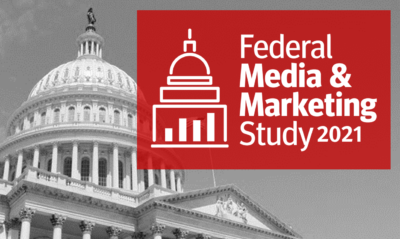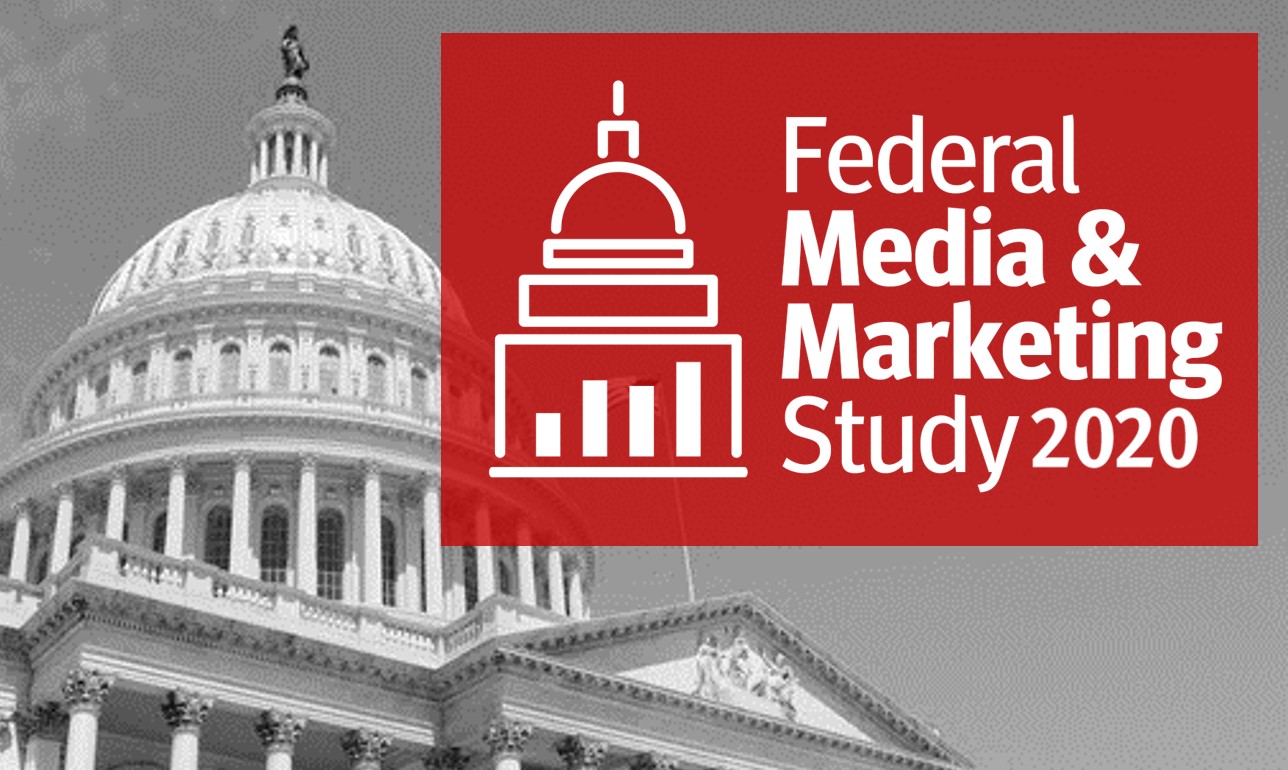federal marketing

Federal Media & Marketing Study 2021
13th Annual Study: On-Demand Video and Presentation Followed by Small Group Discussions
UPDATE! The 2021 FMMS will now be On-demand
Release date: October 21, 2021
Due to concerns with COVID-19 variants, forthcoming mandates, and to protect the health and safety of our participants, we have made the executive decision to transition the 2021 Federal Media & Marketing Study release to on-demand video presentation and download report.
In its 13th year, the Federal Media & Marketing Study continues to empower marketers to hone and perfect their strategic marketing campaigns with valuable and reliable data directly from their federal customers. The survey provides key information about the federal audience’s media usage across print, broadcast, social and digital sources. Combining this data with demographics including: job function, location, purchase area and more, marketers have the ability to slice and dice the data and map each to specific media habits, allowing them to target specific audiences.
The survey represents the views of thousands of federal workers in a variety of positions. Whether you are interested in a broad awareness campaign, or a more focused agency-based marketing effort, data from the study can provide you key insights about the media and marketing habits of this tough-to-reach federal market audience.
WHAT TO EXPECT
- Job Function and Purchase Responsibility – More than 25 different job functions and areas of purchase, by product and service
- Media Usage – 60+ publications, 100+ websites and mobile sites; 10+ social sites; differences inside vs. outside the Beltway
- Trusted Content -To what extent do decision makers trust news and information from different media sources?
- Time Spent Accessing Content – How much time do government employees spend accessing content online, watching TV, listening to the radio and reading e-newsletters?
TWO PANEL DISCUSSIONS
Federal Media Panel: Moderated by Aaron Heffron, Market Connections
- Kevin Baron, Executive Editor, Defense One
- Patti Nuttybombe Cochran, Federal Marketing Consultant, Government Matters Media
- Jeffrey Wolinsky, Director of Federal Sales, WTOP/Federal News Network
Federal Marketing Panel: Moderated by Stephanie Geiger, Government Marketing University
- Matt Bechtel, Director of Corporate Marketing, Booz Allen Hamilton
- Allison Mason, Senior Director, Public Sector Marketing, Red Hat
- Darryl E. Peek II, Head of Federal Strategic Partnerships, Google
ON-DEMAND ACCESS and POST-FMMS ONLINE NETWORKING SESSIONS
- ON-DEMAND VIDEO AND REPORT – Our 2021 report and video presentation will be available to download on October 21. Stay tuned for purchasing capabilities
- SMALL GROUP ONLINE DISCUSSIONS – A series of online groups (no more than 20 per session) will be limited to FMMS on-demand purchasers to discuss results and network with like-minded peers following the FMMS release. Details on registration will be available in after purchase.
PURCHASE THE OVERVIEW & VIDEO!
Overview results from the 2021 Federal Media & Marketing Study highlights high-level results from our comprehensive study surveying thousands of federal respondents at defense and civilian agencies, inside and outside the Beltway about their use of digital, social, mobile, print and broadcast media. This PDF report provides high-level results of the top digital and print publications, social media sites, radio and TV within the DC metro area. A video readout and analysis of the results by President, Aaron Heffron, is included with purchase.
 Increasingly over the past few years, federal marketers have been asked by senior management to prove a positive return on investment on their marketing dollars. In today’s altered landscape, marketers are also faced with having to account for their target audience’s changing work environment and agency priorities. With this in mind, what questions should federal marketers ask before their strategies are developed and investments made?
Increasingly over the past few years, federal marketers have been asked by senior management to prove a positive return on investment on their marketing dollars. In today’s altered landscape, marketers are also faced with having to account for their target audience’s changing work environment and agency priorities. With this in mind, what questions should federal marketers ask before their strategies are developed and investments made?
Who Are You Targeting?
Earlier this year, our President, Aaron Heffron wrote about the difference between expanding versus exploring when it comes to your customer base. Regardless of whether you are looking to expand your customer base to new agencies or looking to build deeper relationships with the agency you are currently working with, it’s important to know your customer’s preferences, learning styles, preferred communication styles and the challenges they are facing.
Agency-based marketing (and even people-based marketing) are terms we hear more and more. Sales and marketing need to work together to develop their buying personas to understand who and how to best approach the marketplace. Using data versus anecdotes will yield the best results. Whether you develop your own personas or look to the Federal IT (FIT) Persona Study, knowing your customer will increase the ROI on any marketing effort.
Will Your Message Resonate?
Before launching any new campaign (especially grand (read: expensive) ones), it’s a good idea to include message testing research in the beginning to create a baseline and ultimately demonstrate the ROI from beginning to end. Pre-testing your messaging provides information on your prospects’ awareness of your brand and a read on how well your message fits within that brand perception. Returning to a similar audience to test the change in awareness and perceptions allows for dynamic message refinements and adjustments to ensure resonance and relevance with your audience. Agency priorities can change swiftly, and contractors often need to be able to change with the tides.
How Should It Be Delivered?
Once you have an idea about what you want to say, how is it best delivered? Depending on whether you want to create awareness or influence buying decisions, your content may need to take different formats.
Public sector marketers know content is king, but you will need to consider your target audience’s learning preferences. Do they tend to read, listen, or watch content to learn more about the services or products? Are they looking for past examples of how new ideas have worked or seeking knowledge (and reassurances) from industry or government thought leaders?
Over the years, we periodically dove into the world of content marketing. Our 2017 Federal Content Marketing Review highlighted what content federal audiences want during the different steps of the buying process. The 2019 Content Marketing Review introduced state and local audiences into the mix. In 2021, we will reprise the study and assess the K-12 and higher-ed markets and review how COVID-19 may have impacted preferences from years past. (Register for the 2021 Content Marketing Review: Reaching the Public Sector)
Where Should You Place It?
Whether earned or paid, you want to ensure the content created is reaching the right eyeballs. In times of tightening budgets, every marketing and advertising dollar spent needs to be well-thought out. Targeting matters. Some media channels can be more effective for a general federal audience, while others can most efficiently reach an agency, agency-type, or professionals with a specific job function or within a purchase category. The Federal Media and Marketing Study provides you data about their media usage across print, broadcast, social and digital sources.
This is especially important in years where their habits may have changed. Various factors are challenging conventional wisdom. With more federal employees teleworking, things such as radio advertising, print advertising and social media use have been deeply affected. Having the data to back your advertising decision will help you decide where to invest your advertising and marketing dollars.
Final Thought
Data-enabled informed strategic decisions can help maximize ROI. Market Connections has spent the past 25 years gathering data and insights from public sector influencers and decision-makers to support our government contracting clients in informing their strategic planning, validating their marketing spend and ensuring the best ROI possible.
Want to learn more or develop a custom study for your audience, contact us at info@marketconnectionsinc.com.
In our last blog post, Should You Reconsider Your 2021 Federal Media Strategy in Light of COVID?, we touched on how to use agency-based marketing (ABM) for media purchasing when space in general federal publications are limited.
Federal marketers are oftentimes challenged with tight budgets and high expectations to produce strong ROIs. Simply, they are expected to do a lot with very little. Agency-based marketing when paired with investments in advertising and other broad marketing strategies can provide a boost to the expected return on investment.
What is one way to maximize a small budget? Effectively connect with the preferences of your TARGET audience with a strong understanding of what makes them tick day to day.
Using Personas to Connect
There are many ways of developing personas, depending on your needs and resources. A good place to start is your own Customer Relationship Management (CRM) tool and your client-facing teams. If you need deeper insights your tool cannot provide or have been surprised by conflicting comments from your teams, you may want to consider third-party research. Using personas helps you drill down on your customers’ preferences and develop a focused strategy tailored specifically to them.
For federal marketers, that can mean a focus on agency type, agency-specific, geographical, or product/service categories. Understanding your customer on a deeper level can help you speak to their personal and professional goals and challenges. For example, if you are targeting an IT end-user, you may focus on educating about more technical features because of their desire to be an expert in their agency, whereas if you were marketing to a procurement specialist, you would want to focus on cost-savings because of their pride in being prompt and efficient. In the same vein, one may prefer to watch a webinar, while another prefers to read a white paper due to their personal learning preferences.
Learn more about Market Connections’ Federal IT Personas.
Consider “Where” They Are Already Going
In addition to content creation, you may want to consider where and how you are advertising or sharing your content. Whether it’s because space is at a premium in some of the more general federal publications, or you are focusing on more niche publications based on your particular audience, understanding where your audience is going for news and information can help get the right eyeballs on your content and drive agency decision-makers to your site.
Ad placement is only one lever you can use and is often most effective to build awareness. If you are having difficulty closing sales among those who know you, consider delivering information and messages through other popular channels among your target audience. They may have a preference for a certain social media platform. They may use certain streaming services to reach specific news programs or tune into radio stations throughout the day. Of those media channels, are there geo-locating advertising opportunities you may want to explore to reach your prospects?
Selecting correctly from your customer’s media buffet of online publications, print publications, social media sites, TV, radio or streaming services can eliminate some of the “guesswork” and improve the ROI on your marketing investment.
Learn more using our annual Federal Media & Marketing Study.
Looking Deeper
Consider diving a little deeper and consider more targeted marketing as part of your overall federal marketing strategy. Beyond creating tailored content that is relevant to your specific audience, also consider the format and placement of that content. Federal marketers have many tools available that can pair nicely with internal intelligence to help make educated decisions about their company’s federal marketing investments.
Insights Pulled from a Sneak Peek of the 2020 Federal Media & Marketing Study

Laurie Morrow, Vice President of Research Strategy
From the desk of Laurie Morrow, Vice President of Research Strategy, Market Connections Inc.
Over the twelve years my team has conducted the Federal Media & Marketing Study, we have looked at how federal audiences are engaging with different media properties from print publications to online to newer social medias. In addition to analyzing readership, we also investigate habits, trends, levels of trust and confidence and time spent with media along with other marketing tactics year over year.
With all the changes and pivots the federal market and those marketing to them had to make this year, I was eager to see whether there would be changes in this year’s results due to the pandemic, elections and other recent major events.
Taking a sneak peek into the findings, I found some interesting results around trust and confidence that while not tied to pandemic, may be a result of a charged political and social climate this year.
Confidence in News
The first is an overall decline in confidence in general news media. Like others, I was not necessarily surprised by this finding, as we started to see some drops in confidence in general news sources last year tied to political party affiliation.
What I did find surprising was seeing a decline in some federally focused media as well this year. Over the years, the level of confidence in federal news outlets has relatively remained unscathed but has distrust now seeped into federal media? Is this due to the charged climate, or do we expect to see this trend continue to grow in an era where “fake news” and general distrust in media grows along political and geographical lines?
Trust in Source
Similar to the level of confidence in news, this year’s results indicate an overall decline in trust of ALL sources of information, from associations to industry pubs to government contractors. While the ranking of trust in sources is relatively the same as last year, the general decline across the board could possibly point to a growing skepticism within the federal audience. In coming years, we will continue to measure that level of trust to see if this continues to trend down or if this current dip in trust is due to the current climate.
Regardless of whether this is a trend or not, this begs an important question, “What can we do as an industry to regain our federal customers’ trust?”
Other Results
In addition to details around the level of confidence in media properties and rank sources of information by trustworthiness, the 2020 Federal Media & Marketing Study most notably studies the readership of general and federal publications, social media site usage, and television viewership and radio listenership (for the DMV), among other marketing tactics. We highlight any differences found by agency type, location (inside the beltway vs. outside), party affiliation, and geography (urban, suburban, rural) among other characteristics, where statistically different.
Learn more about our study, purchase the on-demand overview and/or annual subscription to the dashboard.
https://www.marketconnectionsinc.com/fmms2020study/
 Unbelievably, we are less than 50 days away from this year’s elections. Like in many other big election years, our clients always ask us the same question, “How do you think the elections will affect the federal market?” We believe there are two parts to that question. The immediate one that comes to people’s minds is, “How will whoever wins change (or not) federal spending priorities?” There are many pundits and policy experts that will weigh in on that topic in the coming months. Our interest is in the election process itself: “How does the fact that a presidential election is happening affect the ability of federal employees to do their jobs?”
Unbelievably, we are less than 50 days away from this year’s elections. Like in many other big election years, our clients always ask us the same question, “How do you think the elections will affect the federal market?” We believe there are two parts to that question. The immediate one that comes to people’s minds is, “How will whoever wins change (or not) federal spending priorities?” There are many pundits and policy experts that will weigh in on that topic in the coming months. Our interest is in the election process itself: “How does the fact that a presidential election is happening affect the ability of federal employees to do their jobs?”
Though we are often asked, we generally avoid interviewing elected officials and appointees, preferring to take the pulse of those folks that make and influence the day-to-day decisions at agencies. For the federal market, that can include everyone from end-users to executives, program managers to procurement officers.
What we’ve found in the past is that elections don’t change the values of the people making the day-to-day decisions, because those day-to-day values (e.g., doing their job well, serving their country, being viewed as an expert) are not tied to a political belief system. Those values will affect how your overtures influence the evaluation and selection process.
What elections do, however, is create an air of uncertainty around change in leadership. Will newly appointed agency heads have different ideas on the longer-term, strategic changes as to how work at the agency is approached? Will they allocate budgets differently? Where are their priorities? How will this affect those working at those agencies and their day-to-day activities?
For most of you reading this post, these concerns are out of your control. Federal marketers and client services teams should focus on how their company can support current efforts, be proactive and forward thinking about new directions that may be taken, answer questions that may come up and deliver on promises already made. The number one goal is to support their customers during a time of uncertainty.
Want to know more about how your federal clients are feeling about the upcoming elections? What will their jobs look like over the next month and a half? When do they anticipate budgets to be set? What challenges do they foresee? To answer these questions, we conducted a survey to see how the upcoming elections will affect the federal market.
Join us for our webinar “How the Upcoming Elections Affect Federal Agencies?” on Thursday, September 24, at 2 pm ET.
As we approach the end of the fiscal year, the discussion turns toward agency end-of-year spending. Should federal marketers and sales assume selling for the year is done and look toward 2021, or should they implement a final surge campaign with the hopes of capturing any last-minute spending from unspent budgets?
 According to Lou Anne Brossman, founder and CEO of Government Marketing University, it’s about gauging internal expectations and assessing if your company will be able to meet last minute agency demands. Ask the executive team, “What outcomes do you expect from 4th quarter marketing?” “Is this a last-ditch attempt full of hope or a concerted effort to go after identified opportunities?”
According to Lou Anne Brossman, founder and CEO of Government Marketing University, it’s about gauging internal expectations and assessing if your company will be able to meet last minute agency demands. Ask the executive team, “What outcomes do you expect from 4th quarter marketing?” “Is this a last-ditch attempt full of hope or a concerted effort to go after identified opportunities?”
If you know there are dollars to be spent, ask yourself if your company prepared for a turnkey (i.e. quick) sale? In a recent IDEATION call, Lou Anne discussed tips for marketers at the end of the buying season. Below are a few of her expert tips along with findings from our own studies about the best content for the late stage buying process.
- Do not expect new, unidentified fourth quarter sales from a fourth quarter marketing campaign. Opportunity identification and marketing must start far earlier than that.
Federal marketers and business development professionals understand that selling to the government is not a short sales cycle. Not only should you always be front of mind, you have to consider being there with exactly what they are looking for at the exact time they are looking for it.
Selling to the government is an educational process, and the preparation often starts 12 to 18 months ahead of time. If you are marketing in the fourth quarter, it’s best to market to them for solutions they will be looking for in the next fiscal year’s needs. However, it is always useful to be top of mind if 2021 needs can be moved up with 2020 dollars. (see #2).
With next year in mind, consider that they are now reviewing needs and specifications for NEXT year’s requirements. What content should you be providing them? According to the Federal Content Marketing Review (FCMR), educational pieces such as research reports and white papers are key.
- Given everything said above, there is still a possibility — however remote — to win fourth quarter business at the last minute.
However, this is usually thanks to the marketing you did in the first couple of quarters of the fiscal year. To ensure that you are able to tap into any unspent dollars, consider marketing to where they are in the buying process. The 2017 FCMR study showed us that if they are looking at finalizing a decision quickly (making final selection), they are most likely looking for trials and product demos.
Is your company’s solution “acquisition-ready” for a last-minute sale? According to one chief procurement officer from GMarkU’s discussion, “If [an agency program office is] coming at me in the last quarter of the year especially because you have an unfunded requirement, or even an emergency buy, I’m going to lean towards existing contract vehicles. I’m going to look to things like the government-wide contracts, our strategically sourced contracts, or the GSA schedules, or other vehicles that make it easy for me to get it done quickly.” This means having your sales teams, contract shops and legal departments ready to go and on the same page.
It’s intuitive to make sure your company is set up for the quick sale and you may want to lead your marketing with language stating which vehicles you are on upfront to make it easier for your customer.
- End-of-year procurements are not just for the large, well-established vendors.
While you may think that agency’s will only reach for well-established vendors during last-minute sales, there is a place and space for small business. You should know if there is a portion carved out for small, woman-owned, minority-owned businesses. Does your marketing quickly identify you as such? In addition to what contract vehicles you are on, it is important to identify yourself as SBA, 8a, WOSB, minority-owned, or other, as appropriate.
Small businesses looking for year-end wins should also consider working with a larger vendor who already has experience. Your marketing should consider not only the agency but primes as well. What can you bring to the table for a partner? Does your company have an expertise in a niche that is needed by a prime? Knowledge of how you are perceived can help you strategically market your company’s products and services to key agencies AND partner contractors looking for something specific. Brand research could be a first step in gauging where your strengths, weaknesses and differentiators lie.
Final Thoughts
While it may be daunting to market specifically for those last-minute unspent requirements, it is not without value. It is important to understand end-of-year procurement priorities, provide content that speaks specifically to their needs and ensure you have the right vehicles for easy acquisition.
Messaging that highlights the ability to get next year’s needs addressed now can be appealing to agencies with multiple challenges. Educate them on how you can address issues they may not think they are ready for, focus on your strengths and differentiators, and highlight how you can make the process as easy as possible. These elements will give you the best chance to secure some last-minute commitments you thought weren’t realistic until next year.
Guest blogger: Mark Amtower, Amtower & Company
Market Connections’ Federal IT (FIT) Persona Study should resonate with everyone selling IT products or services to the government. The always evolving IT landscape shortens the cycle of Moore’s Law every day, making it critical for the savvy IT product or services contractor to educate federal buyers on a regular basis. Smart federal marketers understand that to increase the likelihood of success, they need to extend this education process to a broader audience of influencers and decision-makers at target agencies. The FIT Persona Study helps marketers understand each type of persona that can participate in that process.
Once you determine the characteristics of the personas you need to influence, start mapping out content that fits their needs at each stage of the buying process (see, Market Connections’ Federal Content Marketing Review).
According to studies by other major market research firms, buyers begin their journey by doing research online, looking for information on the products and services they are likely to purchase in the relative near term. These studies show that 60%+ of the buying process is researched before outreach to any vendor. Mandiant Security Validation’s (Mandiant Solutions, part of FireEye) Chief Marketing Officer, Tracey Moon, coined this the “dark funnel” in a presentation around the customer journey of Government Marketing University’s 2019 GAIN conference.
Building Content for Your Target Audience
Your content must fit each step of the process starting with the identification of the issue to be resolved. Then you should educate the buyer of the problem area and how it can be addressed. After that, you can educate on what your solution is and does, in what situations it is applicable, ease (or not) of use, etc., developing content specific for each persona in the process.
The newer the technology or technological advance, the bigger the opportunity is to jump in early with good content to educate your customer.
However, key influencers and decision-makers may have differing challenges with technology that need to be addressed and using personas can provide guidance on the types of problems or challenges that need addressing in your content. For example, you may need to address technical challenges for the frontline IT specialist, how it is deployed for the project manager, versus how it can help reach agency mission goals for leadership or how it can be procured to the procurement officer.
The most important thing: develop your content with the idea of educating your customer, not selling to them.
The next step is to understand how they prefer to consume content. If you are targeting end-users, you may be able to get away with one or two formats; however, if you are trying to reach an agency and all their key players, you may want to consider the format in which you develop your content pieces. An end-user may prefer a video, a project manager may prefer a white paper and a CISO may prefer a podcast. One type of content format may not fit all.
Marketing Your Content
Unlike the famous movie quote, “if you build it, they will come,” you cannot create content and expect your customer to find it on their own. Once you have built your content, you need to market that content across different platforms. Use SEO, social media, trade media, and other sources to announce the presence of your content and direct customers back to your resources. Another valuable use of personas is to help you make strategic decisions on where to market based on target personas’ key preferences.
For example, if your key target personas show a preference for using social media such as LinkedIn, there are many ways you can drive traffic to your content:
- Simple, easy and no cost: Post a synopsis and a link, then get your sales, marketing and business development teams to share the content with their networks.
- Group pages: Check agencies’ company pages, click on the “# of employees on LinkedIn,” then use the “All Filters” button to look for specific job titles. Once you find professionals that match your target personas, you can look to see what “groups” they belong to and if possible, join those group(s) and start sharing your content there as well.
- LinkedIn articles: Byline or have company ambassadors (leadership) byline short articles to be published on LinkedIn.
- Advertising: If budgets permit, consider boosting your posts with LinkedIn advertising.
Summary
Educating your government customer in a targeted manner by creating content that addresses their specific challenges, in formats they prefer to learn from, and marketing that content in areas/platforms that they are more likely to visit, can only help increase the likelihood of consideration during the procurement process.
 Mark Amtower has been advising federal contractors of all sizes on the best practices for marketing to the federal government since 1985. Most recently he has focused on social selling, differentiation, building the SME platform and content marketing. He is the author of several books, has hosted a weekly show on the Federal News Network for 14 years, and has been a contributing writer to Washington Technology for 12 years. He is a frequent speaker at industry events. Connect with Mark on LinkedIn.
Mark Amtower has been advising federal contractors of all sizes on the best practices for marketing to the federal government since 1985. Most recently he has focused on social selling, differentiation, building the SME platform and content marketing. He is the author of several books, has hosted a weekly show on the Federal News Network for 14 years, and has been a contributing writer to Washington Technology for 12 years. He is a frequent speaker at industry events. Connect with Mark on LinkedIn.
Federal Media & Marketing Study 2020

12th Annual Study On-Demand Release*
Thursday, October 29, 9 AM
*Due to COVID-19 and the inability to present results in an in-person breakfast, the 2020 study results are available as an on-demand video and downloadable overview presentation.
PURCHASE ON-DEMAND VIDEO & OVERVIEW
ABOUT THE STUDY
In its 12th year, the Federal Media & Marketing Study continues to empower marketers to hone and perfect their strategic marketing campaigns with valuable and reliable data directly from their federal customers. The survey provides key information about the federal audience’s media usage across print, broadcast, social and digital sources. Combining this data with demographics, including job function, location, purchase area and more, marketers have the ability to slice and dice the data and map each to specific media habits, allowing them to target specific audiences.
The survey represents the views of thousands of federal workers in a variety of positions. Whether you are interested in a broad awareness campaign, or a more focused agency-based marketing effort, data from the study can provide you key insights about the media and marketing habits of this tough-to-reach federal market audience.
WHAT TO EXPECT
- Job Function and Purchase Responsibility – More than 25 different job functions and areas of purchase, by product and service
- Media Usage – 60+ publications, 100+ websites and mobile sites; 10+ social sites; differences inside vs. outside the Beltway
- Trusted Content – To what extent do decision makers trust news and information from different media sources?
- Time Spent Accessing Content – How much time do government employees spend accessing content online, watching TV, listening to the radio and reading e-newsletters?
- Media Habits of Federal Employees: A Day in the Life – What media sources are federal employees accessing during different parts of their day?
NEW IN 2020
- The Effects of COVID-19 – From media habits to in-person events, what should marketers know to adjust their strategies?
- Virtual Events and Webinars – With live events on hold for the time being, when it comes to planning your virtual events, what should you take into consideration? What are feds’ preferences?
- Teleworking and Commuting – How much are feds teleworking or commuting and how does this change their media habits?
- Geography – Are there differences among federal employees who live and work in urban, suburban and rural environments?

Aaron Heffron, President, Market Connections
From the Desk of Aaron Heffron, President Market Connections, Inc.
While many of us remember fondly as a kid hearing, “Yes, Virginia, there is a Santa Claus,” we all need to remember, “yes, folks, there will be a federal market after COVID.” Setting aside the debate of when the “after” is a reality, it is not too soon to start thinking about how to position your company to emerge from quarantine stronger and ready for action. You can do this by developing and implementing a marketing plan that accounts for the market realities while it hedges against market uncertainty.
Here are FOUR marketing areas affected by COVID-19 you should reevaluate:
- Events won’t be dead forever, but you’ll need to choose which to attend and sponsor wisely. Our recent COVID related polling of the federal community highlights hesitancy to attend even the smallest of events until the first quarter of 2021. At this point, micro-sized events of under 50 people will be the most likely for federal employees to attend. As you look toward the middle to end of 2021, larger trade shows and conferences may start springing up. Ask event organizers what they are doing to “re-sell” their event. The marketing for the event will be more important than ever as federal employees try to weigh the value of attending. HINT: It’s not only a safety issue.
- Create a webinar strategy that is concise and informative. As remote working and travel restrictions have continued, the prevalence and dependence on webinars has grown. A 45-minute webinar packed with the most recent information, case studies, and forward-looking views is increasingly important as an effective mechanism to educate numerous federal employees at the same time. Rather than scouring online publications and websites for new information, feds are willing to schedule the time to learn both synchronously and asynchronously. Just remember, though, as our content marketing research has shown, minimize the “sell” and maximize the “tell.”
- Adapt your buys to the changes in media usage but hedge your bets. Later this year we will be releasing the 12th edition of the Federal Media and Marketing Study that looks at federal employee preferences for reading, listening and viewing of websites, publications, radio stations and television programming. The survey this year will be measuring habits during the pandemic and we expect to see some drastic changes. The bigger questions will be how long these changes are in place and will longer term behaviors change? Regardless, when the results are public in late October, it will be important to tailor your short-term strategy for media placement and PR to account for these changes. Do not write them off as “temporary” because the tail will be long and may reveal new pathways to the customer.
- Dig deeper to understand what your customer is going through. It will be important to think about how your company will be interactive with your target audience going forward. How affected have your customers and prospects been from the current circumstances? Digging deeper and identifying those specific characteristics of your target audience (including what and who they know) will be necessary, even if you’ve never done it before. Our recent development of federal personas was done with the need for more personal targeting in mind. Individual fears, concerns and values always play a bigger role when there is uncertainty in the market. In 2021 and beyond it will be important to speak to the hearts as well as the minds of the customer as they face fears and concerns that go way past their job responsibilities.
FINAL THOUGHT:
Yes, there will be a federal market in the post-COVID world. What will it exactly look like? Your guess is as good as mine. What we do know now, however, is that with some careful planning and thoughtful actions you can have your organization positioned better than your competitors as new opportunities arise.
Marketing Teams
Our latest blog post “Beyond the C-level Suite” emphasized the importance of marketing to both federal IT decision-makers and influencers at agencies in different ways. Detailed personas for each federal influencer, from senior executive to procurement staff to end user can crystalize your approach and give you guidance as to the unique personal and professional challenges that can influence how and why they make decisions. In part one of this series, we’ll focus on how marketing teams can use federal personas to guide their strategy.
Originating in the consumer market, personas used for B2G will differ in their area of emphasis and approach. While B2C companies focus exclusively on their target customer, B2G marketers must blend the influences of the agency culture with the preferences and habits of the individual. To date, most B2G marketers have focused heavily on the unique aspects of agency culture and processes. We believe that on top of this marketing strategy, it is important to understand the personal motivators and opinions of specific decision-makers and influencers within the agency that is purchasing your product or service.
If you have already made the investment in creating unique federal customer personas, the journey has just begun. There are several next steps to get the best out of your efforts.
Share, Share, Share!
 Federal personas are only effective if you are sharing them across your company, from leadership to marketing and communication teams to sales teams. Educate up and down your organization to consider how each persona plays a part in decision-making. To ensure all teams are considering personas in their sales and marketing efforts, post your personas in visible locations and discuss them frequently in cross-team meetings to incorporate the individual natures of each decision-maker into your company culture.
Federal personas are only effective if you are sharing them across your company, from leadership to marketing and communication teams to sales teams. Educate up and down your organization to consider how each persona plays a part in decision-making. To ensure all teams are considering personas in their sales and marketing efforts, post your personas in visible locations and discuss them frequently in cross-team meetings to incorporate the individual natures of each decision-maker into your company culture.
For Marketing Teams:
Plan your content to be rooted in the agency mission but tailored for specific individuals. This includes adjusting for topic, tone, depth and distribution. You would not market the same way to an executive as you would to an end-user. Their priorities, backgrounds and values may be different. Some may value being viewed as an expert in their jobs, while others value the security that their job provides them.
Furthermore, a tech-savvy end-user, may prefer to watch a video or webinar to learn more about new technologies while a program manager or senior executive may prefer to read about new trends and technologies in a white paper. What is their preference for learning mediums? How do they prefer to receive information?
In addition to the learning style differences, key influencers and decision-makers may prefer different ways to access information. Across the board, marketers understand the importance of SEO, but are you considering other channels for marketing to different federal personas? While one individual may prefer to directly go to a vendor website or video, others may prefer to get information from associations, industry publications or events.
In addition to preferences, use tools like the Federal Media & Marketing Study to understand what publications and websites they’re going to already in order to focus your media and advertising efforts there.
Learn More About Federal Personas:
Purchase the overview report and corresponding video readout:
Federal IT (FIT) Personas Study: A Deeper Look into Your Government Customer
The FIT Personas bundles will be available for purchase soon and will be found on the same page as the overview report.
